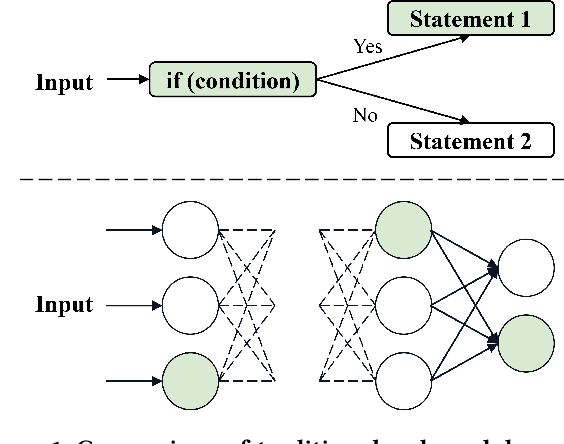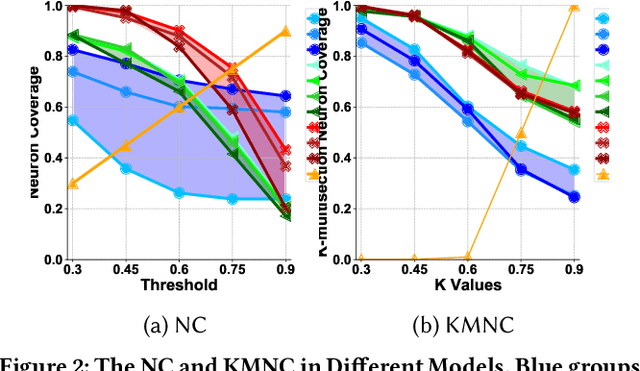Xiaoqi Li
BEVUDA++: Geometric-aware Unsupervised Domain Adaptation for Multi-View 3D Object Detection
Sep 17, 2025Abstract:Vision-centric Bird's Eye View (BEV) perception holds considerable promise for autonomous driving. Recent studies have prioritized efficiency or accuracy enhancements, yet the issue of domain shift has been overlooked, leading to substantial performance degradation upon transfer. We identify major domain gaps in real-world cross-domain scenarios and initiate the first effort to address the Domain Adaptation (DA) challenge in multi-view 3D object detection for BEV perception. Given the complexity of BEV perception approaches with their multiple components, domain shift accumulation across multi-geometric spaces (e.g., 2D, 3D Voxel, BEV) poses a significant challenge for BEV domain adaptation. In this paper, we introduce an innovative geometric-aware teacher-student framework, BEVUDA++, to diminish this issue, comprising a Reliable Depth Teacher (RDT) and a Geometric Consistent Student (GCS) model. Specifically, RDT effectively blends target LiDAR with dependable depth predictions to generate depth-aware information based on uncertainty estimation, enhancing the extraction of Voxel and BEV features that are essential for understanding the target domain. To collaboratively reduce the domain shift, GCS maps features from multiple spaces into a unified geometric embedding space, thereby narrowing the gap in data distribution between the two domains. Additionally, we introduce a novel Uncertainty-guided Exponential Moving Average (UEMA) to further reduce error accumulation due to domain shifts informed by previously obtained uncertainty guidance. To demonstrate the superiority of our proposed method, we execute comprehensive experiments in four cross-domain scenarios, securing state-of-the-art performance in BEV 3D object detection tasks, e.g., 12.9\% NDS and 9.5\% mAP enhancement on Day-Night adaptation.
BiAssemble: Learning Collaborative Affordance for Bimanual Geometric Assembly
Jun 06, 2025Abstract:Shape assembly, the process of combining parts into a complete whole, is a crucial robotic skill with broad real-world applications. Among various assembly tasks, geometric assembly--where broken parts are reassembled into their original form (e.g., reconstructing a shattered bowl)--is particularly challenging. This requires the robot to recognize geometric cues for grasping, assembly, and subsequent bimanual collaborative manipulation on varied fragments. In this paper, we exploit the geometric generalization of point-level affordance, learning affordance aware of bimanual collaboration in geometric assembly with long-horizon action sequences. To address the evaluation ambiguity caused by geometry diversity of broken parts, we introduce a real-world benchmark featuring geometric variety and global reproducibility. Extensive experiments demonstrate the superiority of our approach over both previous affordance-based and imitation-based methods. Project page: https://sites.google.com/view/biassembly/.
SR3D: Unleashing Single-view 3D Reconstruction for Transparent and Specular Object Grasping
May 30, 2025Abstract:Recent advancements in 3D robotic manipulation have improved grasping of everyday objects, but transparent and specular materials remain challenging due to depth sensing limitations. While several 3D reconstruction and depth completion approaches address these challenges, they suffer from setup complexity or limited observation information utilization. To address this, leveraging the power of single view 3D object reconstruction approaches, we propose a training free framework SR3D that enables robotic grasping of transparent and specular objects from a single view observation. Specifically, given single view RGB and depth images, SR3D first uses the external visual models to generate 3D reconstructed object mesh based on RGB image. Then, the key idea is to determine the 3D object's pose and scale to accurately localize the reconstructed object back into its original depth corrupted 3D scene. Therefore, we propose view matching and keypoint matching mechanisms,which leverage both the 2D and 3D's inherent semantic and geometric information in the observation to determine the object's 3D state within the scene, thereby reconstructing an accurate 3D depth map for effective grasp detection. Experiments in both simulation and real world show the reconstruction effectiveness of SR3D.
Facial Recognition Leveraging Generative Adversarial Networks
May 17, 2025



Abstract:Face recognition performance based on deep learning heavily relies on large-scale training data, which is often difficult to acquire in practical applications. To address this challenge, this paper proposes a GAN-based data augmentation method with three key contributions: (1) a residual-embedded generator to alleviate gradient vanishing/exploding problems, (2) an Inception ResNet-V1 based FaceNet discriminator for improved adversarial training, and (3) an end-to-end framework that jointly optimizes data generation and recognition performance. Experimental results demonstrate that our approach achieves stable training dynamics and significantly improves face recognition accuracy by 12.7% on the LFW benchmark compared to baseline methods, while maintaining good generalization capability with limited training samples.
Towards Understanding Deep Learning Model in Image Recognition via Coverage Test
May 12, 2025



Abstract:Deep neural networks (DNNs) play a crucial role in the field of artificial intelligence, and their security-related testing has been a prominent research focus. By inputting test cases, the behavior of models is examined for anomalies, and coverage metrics are utilized to determine the extent of neurons covered by these test cases. With the widespread application and advancement of DNNs, different types of neural behaviors have garnered attention, leading to the emergence of various coverage metrics for neural networks. However, there is currently a lack of empirical research on these coverage metrics, specifically in analyzing the relationships and patterns between model depth, configuration information, and neural network coverage. This paper aims to investigate the relationships and patterns of four coverage metrics: primary functionality, boundary, hierarchy, and structural coverage. A series of empirical experiments were conducted, selecting LeNet, VGG, and ResNet as different DNN architectures, along with 10 models of varying depths ranging from 5 to 54 layers, to compare and study the relationships between different depths, configuration information, and various neural network coverage metrics. Additionally, an investigation was carried out on the relationships between modified decision/condition coverage and dataset size. Finally, three potential future directions are proposed to further contribute to the security testing of DNN Models.
CrayonRobo: Object-Centric Prompt-Driven Vision-Language-Action Model for Robotic Manipulation
May 04, 2025Abstract:In robotic, task goals can be conveyed through various modalities, such as language, goal images, and goal videos. However, natural language can be ambiguous, while images or videos may offer overly detailed specifications. To tackle these challenges, we introduce CrayonRobo that leverages comprehensive multi-modal prompts that explicitly convey both low-level actions and high-level planning in a simple manner. Specifically, for each key-frame in the task sequence, our method allows for manual or automatic generation of simple and expressive 2D visual prompts overlaid on RGB images. These prompts represent the required task goals, such as the end-effector pose and the desired movement direction after contact. We develop a training strategy that enables the model to interpret these visual-language prompts and predict the corresponding contact poses and movement directions in SE(3) space. Furthermore, by sequentially executing all key-frame steps, the model can complete long-horizon tasks. This approach not only helps the model explicitly understand the task objectives but also enhances its robustness on unseen tasks by providing easily interpretable prompts. We evaluate our method in both simulated and real-world environments, demonstrating its robust manipulation capabilities.
3DWG: 3D Weakly Supervised Visual Grounding via Category and Instance-Level Alignment
May 03, 2025Abstract:The 3D weakly-supervised visual grounding task aims to localize oriented 3D boxes in point clouds based on natural language descriptions without requiring annotations to guide model learning. This setting presents two primary challenges: category-level ambiguity and instance-level complexity. Category-level ambiguity arises from representing objects of fine-grained categories in a highly sparse point cloud format, making category distinction challenging. Instance-level complexity stems from multiple instances of the same category coexisting in a scene, leading to distractions during grounding. To address these challenges, we propose a novel weakly-supervised grounding approach that explicitly differentiates between categories and instances. In the category-level branch, we utilize extensive category knowledge from a pre-trained external detector to align object proposal features with sentence-level category features, thereby enhancing category awareness. In the instance-level branch, we utilize spatial relationship descriptions from language queries to refine object proposal features, ensuring clear differentiation among objects. These designs enable our model to accurately identify target-category objects while distinguishing instances within the same category. Compared to previous methods, our approach achieves state-of-the-art performance on three widely used benchmarks: Nr3D, Sr3D, and ScanRef.
A Comprehensive Study of Exploitable Patterns in Smart Contracts: From Vulnerability to Defense
Apr 30, 2025Abstract:With the rapid advancement of blockchain technology, smart contracts have enabled the implementation of increasingly complex functionalities. However, ensuring the security of smart contracts remains a persistent challenge across the stages of development, compilation, and execution. Vulnerabilities within smart contracts not only undermine the security of individual applications but also pose significant risks to the broader blockchain ecosystem, as demonstrated by the growing frequency of attacks since 2016, resulting in substantial financial losses. This paper provides a comprehensive analysis of key security risks in Ethereum smart contracts, specifically those written in Solidity and executed on the Ethereum Virtual Machine (EVM). We focus on two prevalent and critical vulnerability types (reentrancy and integer overflow) by examining their underlying mechanisms, replicating attack scenarios, and assessing effective countermeasures.
AI-Based Vulnerability Analysis of NFT Smart Contracts
Apr 24, 2025



Abstract:With the rapid growth of the NFT market, the security of smart contracts has become crucial. However, existing AI-based detection models for NFT contract vulnerabilities remain limited due to their complexity, while traditional manual methods are time-consuming and costly. This study proposes an AI-driven approach to detect vulnerabilities in NFT smart contracts. We collected 16,527 public smart contract codes, classifying them into five vulnerability categories: Risky Mutable Proxy, ERC-721 Reentrancy, Unlimited Minting, Missing Requirements, and Public Burn. Python-processed data was structured into training/test sets. Using the CART algorithm with Gini coefficient evaluation, we built initial decision trees for feature extraction. A random forest model was implemented to improve robustness through random data/feature sampling and multitree integration. GridSearch hyperparameter tuning further optimized the model, with 3D visualizations demonstrating parameter impacts on vulnerability detection. Results show the random forest model excels in detecting all five vulnerabilities. For example, it identifies Risky Mutable Proxy by analyzing authorization mechanisms and state modifications, while ERC-721 Reentrancy detection relies on external call locations and lock mechanisms. The ensemble approach effectively reduces single-tree overfitting, with stable performance improvements after parameter tuning. This method provides an efficient technical solution for automated NFT contract detection and lays groundwork for scaling AI applications.
Mining Characteristics of Vulnerable Smart Contracts Across Lifecycle Stages
Apr 21, 2025



Abstract:Smart contracts are the cornerstone of decentralized applications and financial protocols, which extend the application of digital currency transactions. The applications and financial protocols introduce significant security challenges, resulting in substantial economic losses. Existing solutions predominantly focus on code vulnerabilities within smart contracts, accounting for only 50% of security incidents. Therefore, a more comprehensive study of security issues related to smart contracts is imperative. The existing empirical research realizes the static analysis of smart contracts from the perspective of the lifecycle and gives the corresponding measures for each stage. However, they lack the characteristic analysis of vulnerabilities in each stage and the distinction between the vulnerabilities. In this paper, we present the first empirical study on the security of smart contracts throughout their lifecycle, including deployment and execution, upgrade, and destruction stages. It delves into the security issues at each stage and provides at least seven feature descriptions. Finally, utilizing these seven features, five machine-learning classification models are used to identify vulnerabilities at different stages. The classification results reveal that vulnerable contracts exhibit distinct transaction features and ego network properties at various stages.
 Add to Chrome
Add to Chrome Add to Firefox
Add to Firefox Add to Edge
Add to Edge